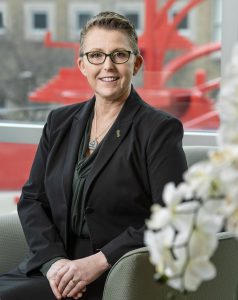Contributed by Wright State University President, Sue Edwards, Ph.D.

Wright State President Sue Edwards
Even before COVID-19 was a national crisis, higher education in the United States found itself at a crossroads: The looming challenges associated with declining enrollment, the rising cost of attendance, the growing lack of confidence in higher education and the increasing call for institutions to be relevant to the communities that they serve.
As a biologist, my research has focused on how biological organisms that are capable of adapting to stressors in their changing environment continue to thrive and be successful.
In many ways, organizations and industries behave in the same way as organisms. They often exist in one form, but inevitably they experience disruptions that force them to change, or face the threat of becoming obsolete. Some leaders see the challenges on the horizon and move to alter operations before their hands are forced. That’s not to say that such change is easy. Significant change is usually hard, and in some cases painful, but it also holds the promise that organizations can come through difficult times and thrive. Change sets the stage for success and can lead to new periods of improved services and innovation — a reality that Dayton knows well from its storied and proud history of innovating and changing the world.
At Wright State, our promise is to provide students access to a very affordable high-quality four-year education. We often say we measure ourselves not by who we exclude but by who we include. Among dozens of four-year universities and colleges in Ohio, Wright State’s in-state undergraduate tuition remains among the most affordable in the state.
Wright State’s externally sponsored grant and contract awards regularly approach $100 million. More than half of that funding is used to support basic and applied research projects, capitalizing on Wright State’s expertise in the areas of sensors, health care, human performance, cybersecurity, and cognitive and social sciences.
Wright State’s successes are the Dayton region’s successes and the Dayton region’s successes are Wright State’s successes.
Today Wright State is addressing difficult challenges to ensure we will be here to deliver on its mission and support our region for generations to come. The university’s financial health continues to be stable and steady. However, following the trends forecast at local, state and national levels, our university enrollment has declined. Last fall, we reported an enrollment of just over 12,000 to the Ohio Department of Higher Education. That means the university’s overall enrollment has declined more than 30% over the past five years.
In our continuing efforts to preserve our ability to offer an extremely affordable, high-quality public education to the Dayton region, Wright State is adapting. The university has initiated a process that will result in a reimagining of the academic enterprise with a goal of assuring our future success. Similar to other universities, Wright State will enact faculty workforce reductions to align academic resources with future projected enrollments. This is one of the most difficult decisions any institution must make, but the process is one that is agreed-upon with the faculty union and is built into the current collective bargaining agreement. The workforce reductions mentioned above are but one component of our overall efforts to align teaching and programmatic resources with the delivery of an affordable, quality education to a smaller, recurring enrollment of approximately 10,000 students.
Wright State University is absolutely essential to the success of the Dayton region. Our graduates remain here and contribute to the success of the businesses, organizations, and communities where they work and live. These initiatives are all seated in assuring we remain viable and continue to be what the Dayton region, the state of Ohio, and our students and families need us to be.
And so, we are following the same compass that we always have. We are adapting to meet the needs of our students and the region we serve. Our ecosystem may be in flux, but our values remain the same.
View the original post at daytondailynews.com

 Heavy metal learning
Heavy metal learning  State grants to bolster Wright State’s electric vehicle and advanced manufacturing training for students
State grants to bolster Wright State’s electric vehicle and advanced manufacturing training for students  Wright State partners with local universities, hospitals to expand mental health care for students
Wright State partners with local universities, hospitals to expand mental health care for students  Wright State students, first responders team up for Halloween event
Wright State students, first responders team up for Halloween event  Explore Wright State Day welcomes hundreds of future Raiders
Explore Wright State Day welcomes hundreds of future Raiders 